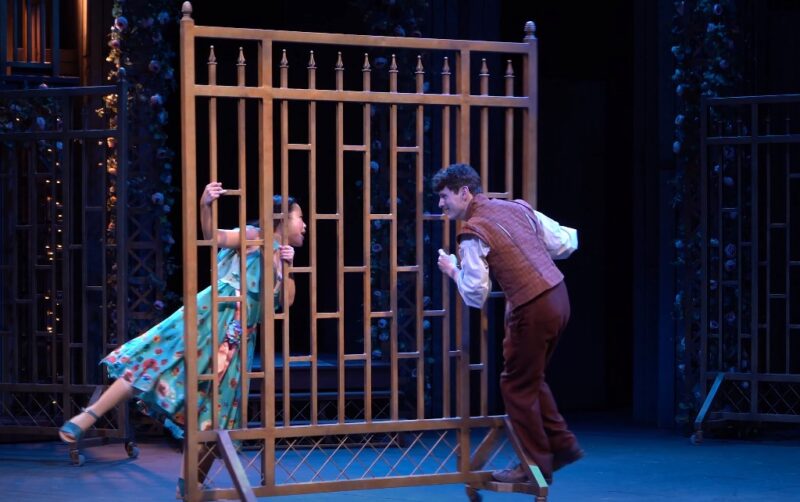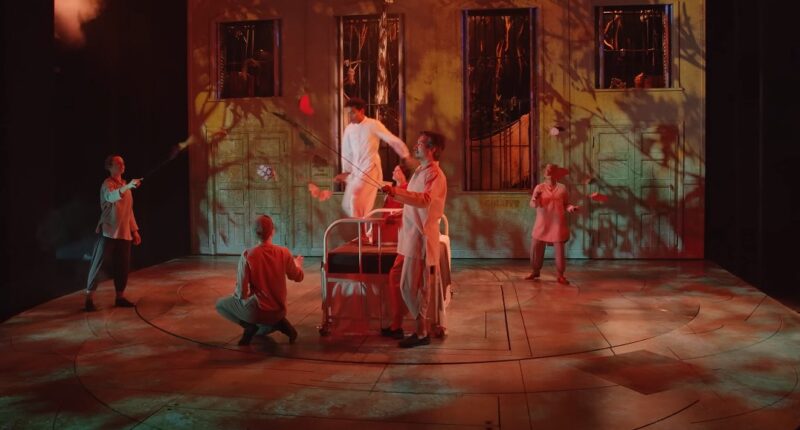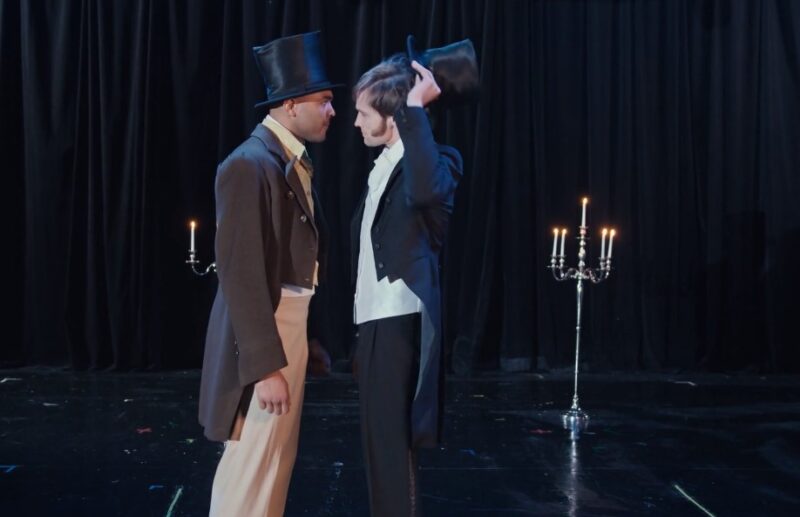Stage directions are the step-by-step guide for everyone involved in a play, written by the playwright or scriptwriter. They cover everything from what the characters do and how they move to details about their costumes, looks, lighting, sound effects, scenery, and even the emotions they should convey.
These directions are like the playbook for a successful performance, making sure that everyone is on the same page and contributing to a captivating and meaningful theatrical experience. Without them, a play would lack the necessary direction and coherence, making stage directions an indispensable element in the art of theatrical storytelling.
What Are Stage Directions?
Stage directions are the instructions that the playwright or the scriptwriter gives to the actors, the director, and the technical crew about how to perform a play or a scene. They are usually written in parentheses or brackets, and they can appear before, after, or within the dialogue.
Stage directions can include information about:
Action and Movement
These are the most common types of stage directions. They tell the actors how to move on the stage, such as where to stand, sit, walk, run, dance, etc.
They also describe what the actors are doing, such as picking up an object, looking at someone, smiling, crying, etc. For example, “(He picks up the phone and dials.)” or “(She crosses to the window and stares outside.)”
Costumes and Appearance

These directions tell us what the actors wear, how they look, and any changes in their appearance throughout the play. They can also show the age, gender, ethnicity, and personality of the characters.
For instance, it might say, “He is wearing a tuxedo and a bow tie,” or “She has long blonde hair and a scar on her cheek.”
Lighting, Sound, and Scenery
All these details work together to set the mood, atmosphere, and tone of the play. For example, it might say, “A spotlight falls on her,” or “Thunder and lightning. A stormy night.”
Emotions and Attitudes
These directions show how actors should feel and express emotions like happiness, sadness, anger, or fear. They also suggest how to say lines, whether loudly, softly, sarcastically, and so on.
They also help share the character’s motivation, intention, and personality. For instance, it might say, “He laughs nervously,” or “She says coldly.”
How to Read Stage Directions

Upstage is the part of the stage that is furthest from the audience, while downstage is the part that is closest to the audience. The center stage is the middle of the stage.
Each zone can be further divided into three or five sections: left, right, and center, or left-center, right-center, and center. Here is a diagram that shows the stage directions:
| UL | ULC | UC | URC | UR |
|---|---|---|---|---|
| DL | DLC | DC | DRC | DR |
| L | LC | C | RC | R |
UL: Upstage left URC: Upstage right-center DL: Downstage left DRC: Downstage right-center L: Left C: Center R: Right
Reading Stage Directions – Steps
- Identify the zone and section mentioned in the stage direction. For example, “(He moves to DR.)” means downstage right, closest to the audience and to the actor’s right.
- Recognize the type of movement described. For instance, “(She crosses to UL.)” signifies walking from the current position to upstage left, farthest from the audience, and to the actor’s left.
- Understand the action or emotion indicated. For example, “(He sits on the couch and sighs.)” implies moving to the couch, expressing disappointment or frustration.
Examples of Stage Directions
- “(She enters from L.)”: She comes on the stage from the left side, which is the audience’s right side.
- “(He exits to UR.)”: He leaves the stage from the upstage right section, which is the part of the stage that is furthest from the audience and to the actor’s right.
- “(They hug and kiss at C.)”: They embrace and kiss each other at the center of the stage, which is the middle of the stage.
- “(She looks at him angrily.)”: She turns her head and eyes to him, showing her anger with her facial expression.
- “(He whispers in her ear.)”: He leans in close to her and speaks softly in her ear so that the audience cannot hear what he says.
How to Follow Stage Directions

Stage directions are meant to guide the actors, but they are not rules that must be followed exactly. They are suggestions that can be adapted, modified, or ignored, depending on the director’s vision, the actor’s interpretation, and the practical limitations of the stage.
Here are some tips on how to follow stage directions effectively.
Make it short and sweet
The directions are like a map for performers, so it’s best to keep them clear and simple for easy understanding. Don’t use long and complicated directions that might confuse or distract actors and the audience.
For instance, instead of saying “(He walks slowly to the door, opens it, looks outside, sees something that scares him, closes the door, locks it, and runs back to the couch.)”, you can say “(He checks the door and runs back.)”
Consider motivation
A script may tell an actor to walk quickly downstage center and little else. But why does the character do that?
What is their goal, their intention, their emotion? As an actor, you need to understand the motivation behind your movements and actions, and not just follow them mechanically.
If the character walks quickly downstage center because they are excited to see someone, you can show that by smiling, waving, or jumping.
Use the space

They often tell actors where to stand using terms like upstage, downstage, center, left, and right. Remember, these terms are from the actor’s view, not the audience’s.
As an actor, it’s important to know how to use your space wisely. Moving upstage can make characters seem distant or create tension while moving downstage can make things more intimate or focused.
Moving left or right can bring balance or contrast. You can also use the space to show your character’s feelings.
A bold character might take up a lot of room, but a shy one might stay in a corner.
Listen and React
As an actor, go beyond actions; consider what you see, hear, and feel. Pay attention to fellow actors and the stage.
Listen to words, tone, and body language, reacting accordingly. Be mindful of sounds, lights, props, and scenery, understanding their impact.
If you hear a loud noise offstage, express surprise, fear, curiosity, or indifference based on your character. Stay flexible and creative, as stage directions can change.
Be open to experimentation, improvisation, and collaboration. Infuse your own touch to make directions memorable; for instance, with “(She kisses him.)”, decide how, where, for how long, and your reaction after the kiss.
FAQ
How can I memorize stage directions easily?
Various methods exist for memorizing stage directions based on your preference and learning style. Common approaches include mnemonics like “Up, Down, Center, Left, Right” (UDCLR), visual aids such as diagrams or maps, physical cues like pointing or gesturing, and associations linking directions with words, colors, sounds, or emotions.
How to write stage directions for my own script?
When writing stage directions for your script, consider the purpose, tone, and style. Guide rather than dictate, ensuring a tone that matches your script’s overall mood and using clear, concise, and consistent language. Adhere to the appropriate format conventions for your genre, medium, and publication, always keeping in mind that your primary audience is the actors and the director.
How can I read stage directions aloud when performing a script?
Reading stage directions aloud is challenging yet useful in a performance. Ensure proper timing, volume, tone, and minimal expression to enhance the delivery without interrupting or overpowering the dialogue.
What steps can I take to enhance my skills in stage direction as an actor?
Improve your stage direction skills by observing, imagining, communicating, and collaborating. Learn from others, explore possibilities for your character, adapt based on communication, and collaborate with the team for a better production.
What are some common mistakes or pitfalls to avoid when following stage directions?
Avoid common pitfalls when following stage directions, such as ignoring, misinterpreting, overdoing, or contradicting them. Ignoring may lead to confusion, misinterpreting errors, overdoing to distraction, and contradicting to conflict. Stay mindful to ensure a smooth and accurate execution of the directions.
Final Words
Stage directions are the indispensable blueprints for a successful theatrical production, guiding everyone involved from the playwright to the actors and technical crew. They provide a detailed roadmap for the physical and emotional aspects of a play, ensuring that every element contributes to a captivating and meaningful performance.
Without stage directions, a play would be a fragmented and disjointed experience, lacking the coherence and direction essential for theatrical storytelling. They are the invisible threads that weave a play together, transforming mere words on a page into a vibrant and engaging theatrical experience.

